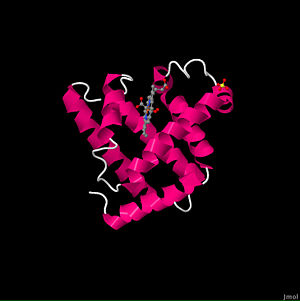User:Sandip Suresh/Sandbox 1
From Proteopedia
(New page: =='''Voltage-gate potassium channel'''== oxymyoglobin 1MBO ===Background=== --- ==Voltage-gated potassium (Kv) channels== fall under a lar...) |
|||
| Line 3: | Line 3: | ||
===Background=== | ===Background=== | ||
--- | --- | ||
| - | + | Voltage-gated potassium (Kv) channels fall under a large family of closely related transmembrane proteins that are present in nearly all classes of living organisms (Long et al., 2005; Rasband, 2010). Among other purposes, voltage gated potassium channels play a critical role during the repolarization phase of neuronal action potentials (Yellen, 2002; Armstrong, 1971). The action potential is a short-lived spike in membrane voltage that begins with a rush of Na+ ions into the neuron that subsequently causes an increase in the voltage across the plasma membrane. At the peak of the action potential, the Kv channel slowly opens up to let a K+ current flow down its gradient and out of the cell (Yellen, 2002; Long et al., 2007). This crucial function of the Kv channel allows the neuron to reestablish its resting voltage and get ready for its next action potential (Armstrong, 1971; Long et al., 2005). | |
Even before the structural determination of the membrane protein was possible, the physiological functions of potassium channels were studied at great lengths. Early research depended on a mutant strain of Drosophila dubbed “Shaker”, initially noticed for its eponymous behavior. When the mutant gene was cloned and sequenced, the gene was found to be similar to known ion channels (Tempel et al., 1988). Further study with channel antagonists helped define the protein’s physiological role. Tetraethylammonium was one such channel antagonist that was used to show that the channel acts as a pore that selectively allows potassium ions to cross the otherwise impermeable plasma membrane (Armstrong, 1971). Furthermore, it was shown that the Kv channel was able to control the flow of K+ in response to changes in voltage across the membrane (Yellen, 2002). The astounding selectivity in choosing potassium ions to let through the membrane, as well as its ability to sense and react to the voltage across the cell’s membrane was, for many years, a fascinating enigma that accordingly garnered widespread interest by many (Doyle et al., 1998; Ahern and Horn, 2004). Recently, the groundbreaking structural determination of the Kv channel has begun to reveal the mechanisms by which the Kv channel manages these remarkable tasks. | Even before the structural determination of the membrane protein was possible, the physiological functions of potassium channels were studied at great lengths. Early research depended on a mutant strain of Drosophila dubbed “Shaker”, initially noticed for its eponymous behavior. When the mutant gene was cloned and sequenced, the gene was found to be similar to known ion channels (Tempel et al., 1988). Further study with channel antagonists helped define the protein’s physiological role. Tetraethylammonium was one such channel antagonist that was used to show that the channel acts as a pore that selectively allows potassium ions to cross the otherwise impermeable plasma membrane (Armstrong, 1971). Furthermore, it was shown that the Kv channel was able to control the flow of K+ in response to changes in voltage across the membrane (Yellen, 2002). The astounding selectivity in choosing potassium ions to let through the membrane, as well as its ability to sense and react to the voltage across the cell’s membrane was, for many years, a fascinating enigma that accordingly garnered widespread interest by many (Doyle et al., 1998; Ahern and Horn, 2004). Recently, the groundbreaking structural determination of the Kv channel has begun to reveal the mechanisms by which the Kv channel manages these remarkable tasks. | ||
Revision as of 04:29, 30 April 2011
Voltage-gate potassium channel
Background
--- Voltage-gated potassium (Kv) channels fall under a large family of closely related transmembrane proteins that are present in nearly all classes of living organisms (Long et al., 2005; Rasband, 2010). Among other purposes, voltage gated potassium channels play a critical role during the repolarization phase of neuronal action potentials (Yellen, 2002; Armstrong, 1971). The action potential is a short-lived spike in membrane voltage that begins with a rush of Na+ ions into the neuron that subsequently causes an increase in the voltage across the plasma membrane. At the peak of the action potential, the Kv channel slowly opens up to let a K+ current flow down its gradient and out of the cell (Yellen, 2002; Long et al., 2007). This crucial function of the Kv channel allows the neuron to reestablish its resting voltage and get ready for its next action potential (Armstrong, 1971; Long et al., 2005).
Even before the structural determination of the membrane protein was possible, the physiological functions of potassium channels were studied at great lengths. Early research depended on a mutant strain of Drosophila dubbed “Shaker”, initially noticed for its eponymous behavior. When the mutant gene was cloned and sequenced, the gene was found to be similar to known ion channels (Tempel et al., 1988). Further study with channel antagonists helped define the protein’s physiological role. Tetraethylammonium was one such channel antagonist that was used to show that the channel acts as a pore that selectively allows potassium ions to cross the otherwise impermeable plasma membrane (Armstrong, 1971). Furthermore, it was shown that the Kv channel was able to control the flow of K+ in response to changes in voltage across the membrane (Yellen, 2002). The astounding selectivity in choosing potassium ions to let through the membrane, as well as its ability to sense and react to the voltage across the cell’s membrane was, for many years, a fascinating enigma that accordingly garnered widespread interest by many (Doyle et al., 1998; Ahern and Horn, 2004). Recently, the groundbreaking structural determination of the Kv channel has begun to reveal the mechanisms by which the Kv channel manages these remarkable tasks.

